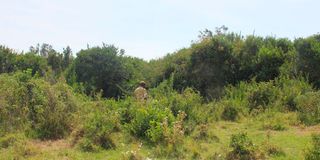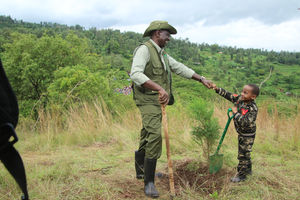Inside wildlife sanctuary plan to revive degraded Chepalungu Forest

Part of Siongiroi bloc of Chepalungu Forest in Bomet County, which the government plans to introduce wild animals to help in conservation efforts.
What you need to know:
- For more than three decades, Chepalungu Forest, once a dense and thriving ecosystem, has suffered massive destruction due to illegal logging, human encroachment and unsustainable agricultural activities.
Efforts to rehabilitate the degraded Chepalungu Forest in Bomet County have been intensified, with the government unveiling plans to introduce wild animals into the once thriving natural habitat.
The initiative aims to restore biodiversity, enhance eco-tourism and provide alternative livelihoods for local communities that have long relied on the forest’s resources.
For more than three decades, Chepalungu Forest, once a dense and thriving ecosystem, has suffered massive destruction due to illegal logging, human encroachment and unsustainable agricultural activities.
The forest, divided into two main blocks of Kapchumbe (4,000 hectares) and Siongiroi (871 hectares), was once rich in indigenous tree species including cedar, Olea, Nandi flame, African wild olive and red stinkwood.
However, unchecked deforestation in the early 1980s drastically reduced tree cover, transforming the forest into a shadow of its former self.
Efforts to conserve Chepalungu have faced numerous hurdles, with the Kenya Forest Service (KFS), the agency mandated to protect forests, often accused of complacency and complicity in the destruction.
For years, powerful timber merchants and local communities harvested trees indiscriminately while conservation authorities struggled to enforce regulations.
But since 2015, a concerted push from conservation organisations, government agencies and local communities has led to a turnaround in efforts to restore the forest.
With support from both national and county governments, initiatives have been launched to rehabilitate degraded areas, control human encroachment and reintroduce wildlife to the ecosystem.
Monkeys, hyenas and various bird species (including cranes) inhabit the remaining forest patches.
Plans are underway to introduce additional wildlife such as zebras, warthogs and antelopes, which are expected to thrive in the region. The addition of other species will depend on scientific studies and expert recommendations from KWS.
Secretary for Conservation at the State Department of Wildlife John Chumo emphasised the importance of providing a conducive environment for the animals.
He noted that turning Chepalungu Forest into a wildlife sanctuary aligns with the Wildlife Conservation and Management Act 2013 and the Wildlife Policy of 2020.
“Creating a wildlife sanctuary in Chepalungu forest would help address issues of deforestation, biodiversity degradation, land encroachment and providing alternative livelihoods to the local community,” Dr Chumo stated.
“With the planned introduction of wild animals in the forest, buffer zones will be created to curb cases of human-wildlife conflicts while enhancing community collaboration and participation in managing the natural resource for sustainability to be achieved,” Dr Chumo said.
Chepalungu Forest is part of the larger Mau Forest Complex, a critical water tower in Kenya.
Rivers such as Mara, Sondu, and Nzoia originate from the Mau Complex and support millions of livelihoods downstream.
Within Chepalungu Forest, smaller streams like Chemaetany, Kapchetirorit, Kapkibos, Atebwo, Reberwet and Legetetiet feed into the Mara River, providing a crucial water source for both humans and wildlife.
The forest’s restoration is a multi-stakeholder effort involving local and international conservation organisations.
The key partners include the World Wide Fund for Nature , US Forest Working Group, East African Wildlife Society, National Alliance Community Forest Association, Green Belt Movement and Tourism Trust Fund.
Others are the Kenya Tourism Board, KWS, KFS, Nature Kenya, the National Environmental Management Authority and Kenya Forest Restoration Network.
The Siongiroi block of the forest has been earmarked for eco-tourism projects due to its diverse vegetation, including woodlands, grasslands, riverine ecosystems and swamps, which are ideal habitats for wildlife.
Bomet Governor Hillary Barchok expressed his administration’s commitment to working with stakeholders to enhance conservation efforts.
He noted that a wildlife sanctuary in Chepalungu would complement the world-famous Maasai Mara Game Reserve in the neighbouring Narok County, further solidifying the region’s status as a premier tourist destination.
“Chepalungu’s proximity to Mara Game Reserve and Serengeti National Park in Tanzania presents a unique opportunity to develop Bomet County’s hospitality industry. The introduction of wildlife will attract tourists, create jobs, and generate revenue for both county and national governments,” said Governor Barchok.
The government is also constructing a 21.8-kilometre solar-powered electric fence around the Siongiroi block.
An additional 10-kilometre internal fence has already been completed. The electric fence has six gates with ranger outposts and a centralised powerhouse.
KFS Chief Conservator of Forests Alex Lemarkoko noted that the fencing project will allow indigenous tree species to regenerate while preventing illegal activities such as logging and encroachment.
“The focus is not just on planting tree seedlings, but nurturing them to maturity. In the past, afforestation programmes failed because there was little emphasis on tree care after planting. This time, we are ensuring that conservation efforts are sustainable,” said Mr Lemarkoko.
Chepalungu Fores alsot plays a crucial role in Kenya’s ambitious plan to plant 15 billion trees by 2032. As part of restoration efforts, 1.1 million indigenous tree seedlings and 700,000 exotic seedlings have been planted in the forest.
Additionally, 1,559 hectares of gazetted forest land have been rehabilitated, 500 hectares have been allocated for agroforestry, and 100 hectares of woodlots have been established.
Susan Boit, the national coordinator for the initiative, said conservation efforts must go beyond tree planting to include active protection and sustainable land use practices.
“The government is working with local communities, donor agencies, and institutions to establish tree nurseries in rural and urban areas. This will provide seedlings for afforestation efforts across the country,” said Ms Boit.
The darkest period for Chepalungu Forest was during the 2007-2008 post-election violence when local communities attacked forest rangers, destroyed their houses and offices and indiscriminately cut down trees.
However, the formation of the Chepalungu Apex Community Forest Association in 2008 has been instrumental in reversing deforestation.
“The local community is fully behind forest restoration efforts and actively participates in decision-making processes. We are engaged in income-generating projects such as beekeeping, eco-tourism, and herbal medicine production, all of which are tied to conservation efforts,” said Community Forests Association Chairman Joseph Towett.
nenyonn@gmail.com

